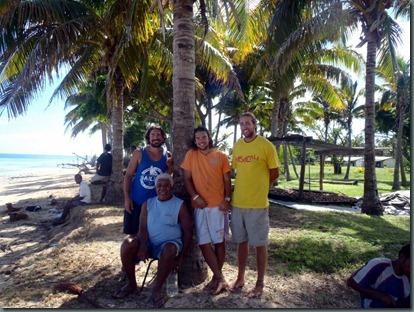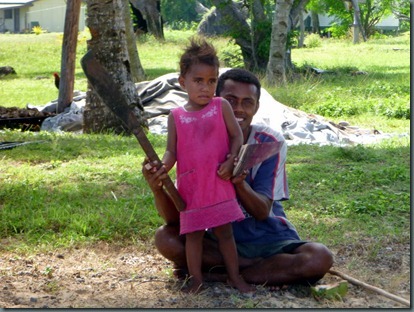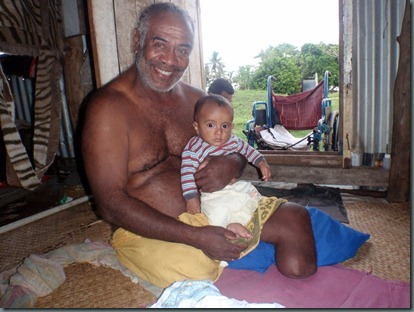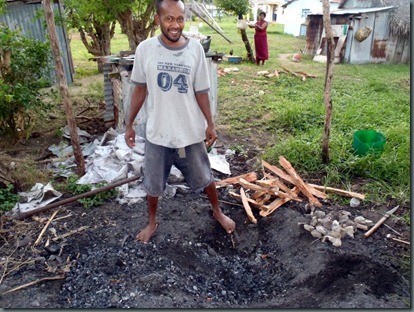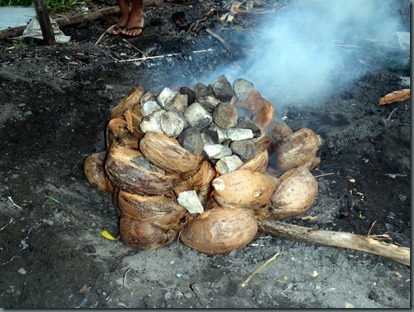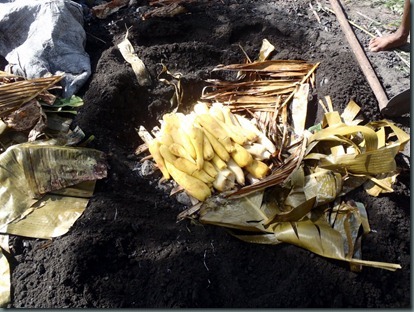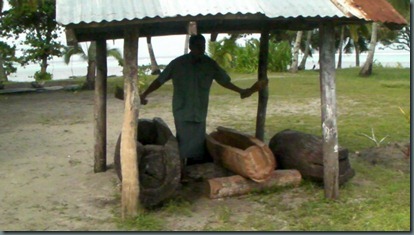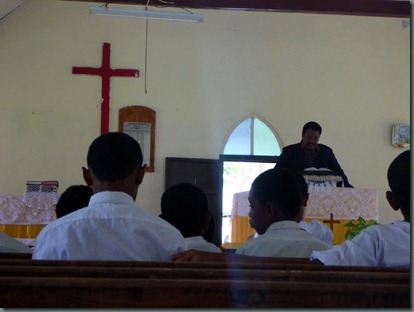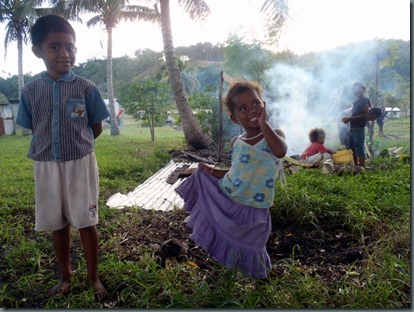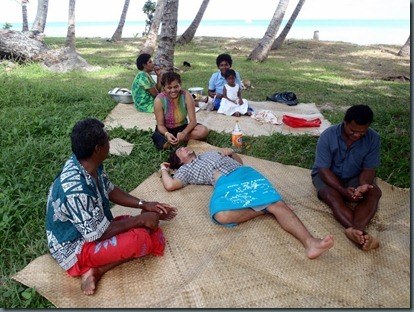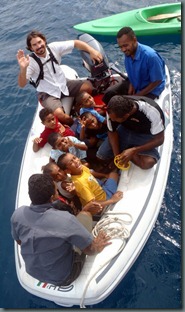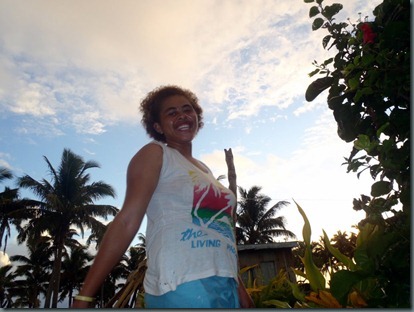“Are you coming to church with us tomorrow?” Of course we are Timothy! We’re really interested in seeing the service. “OK, the first service is at 5AM and lasts until 6AM. At 6AM we start cooking all the days meals in the underground oven. Then there’s another service at 10:00AM. Then we eat lunch and rest before the last service at 5:00PM.”
Wow, three services starting at 5AM ran through my mind. This didn’t sound like a day of rest at all. I told Timothy I was really interested in seeing the underground oven. Could I come in after the first service and watch them prepare it? “Yes, of course. Just come in at 6AM and we’ll show you the lovo. Then you can go to the 10AM service and we’ll have lunch.” Sounds like a plan Timothy. His eyes lit up when I told him I’d bake some fresh bread for lunch and bring in a special treat for after the service.
My 5:45AM alarm was as early as it sounds. How badly did I want to see this lovo? I figured if I can wake up for watch while sailing I should be able to do the same at anchor. How often do you get invited to see traditional Fijian cooking? I rolled out of my bunk and put on some much needed coffee. It was a still and beautiful morning, with the sun just starting to peek over the horizon. Brady, Paul, and Darren were still on their camping adventure on top of the island so I took a nice leisurely solo dinghy ride into shore. Timothy was waiting under a coconut tree on the beach. He ran out into the ankle deep water to grab the dinghy painter.
He was bright eyed and very energetic, each movement having so much purpose as he helped me pull the dinghy above the tide line on the beach. “You’re just in time Brian! We already have the hole dug and are ready to start cooking!” Wow, what happened to Island Time? It was 6:07 and seems I was holding up the show. They were all waiting for me before starting.
Timothy told me that the lovo was the best way to cook. They used it to cook cassava, taro, yams, fish, and even whole pigs when they slaughtered one. “Today we are going to cook cassava” Timothy said. I asked him where the fish was we speared yesterday. “The fish is being cooked by the women. Here only the women cook the fish and the men cook the cassava.” Why is that Timothy? How come you don’t just cook everything together? He looked at me like I was silly for asking such a question. “That’s just the way it’s always been. The women cook the fish that men spear.” Fair enough. Hard to argue with hundreds of years of tradition.
I arrived at the cooking area to find a shallow hole dug in the ground filled with dried coconut husks. The coconut husks were covered with black volcanic rocks that litter the shore. The husks are lit on fire and allowed to burn until the rocks are white-hot, then they are removed leaving the burning hot rocks to fill the bottom of the hole.
Heating up the rocks with coconut husks.
The rocks are covered with a lattice work of green palm shoots. The food is placed on top of the palm shoots, then covered with coconut fronds. The whole thing is covered in a few inches of dirt and left to bake while everyone goes about their business (church). No electricity, no cooking gas, no pots or pans, just what is readily available on the island.
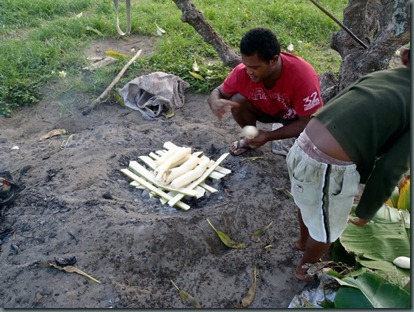
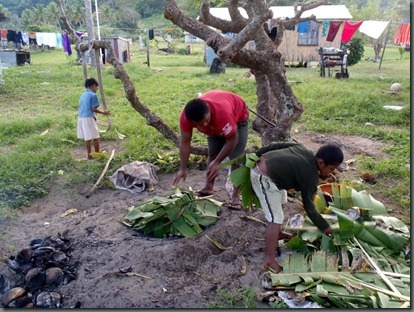
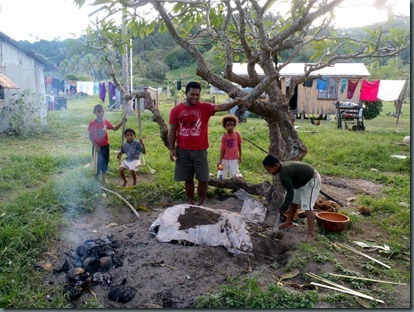
Church is a huge deal here and such a central point of village life. Instead of church bells to call everyone in they beat on huge, hollowed out logs. The logs are easily 8 feet long and 3 feet thick with the center carved creating a huge drum. The logs are beat in a slow rhythm, alternating between two of the logs placed side by side. As the service approaches the rhythm speeds up and up until it ends in an orgy of fast paced beats screaming “Better be here now or you’re gonna be late!”
With everyone wearing their Sunday best the villagers stream in the door. The choir sits up front on the right, the children sit up front on the left, and everyone else fills in behind them. All the villagers put on their Sunday best. Even the dirtiest, grungiest farmer wearing nothing but torn shorts the day before is cleaned up and looking sharp. Nothing says I’m going to church more than a dress pocket sulu, white shirt, and tie.
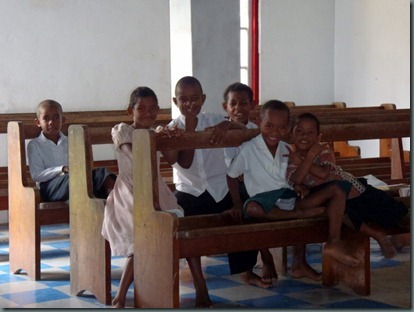
The predominant sects we’ve seen are Methodist and Wesley. On Totoya they are Wesley. The sermon was pretty intense at times with the preacher raising his voice and pounding his fist on the pulpit. You didn’t need to be fluent in Fijian to realize he was pouring out some real fire and brimstone stuff.
The singing was harmonious and beautiful in it’s simplicity. No drums, no guitars, no piano or organ. Just a bunch of Fijians standing up and singing their hearts out. The service was entirely in Fijian except for the special prayer and blessing they did for Delos and her crew. To my surprise I was then asked to give a speech in front of the congregation. I thanked them for their hospitality and warm welcome to their village. I said we were here to see their culture and way of life, that they were blessed themselves to live in such a beautiful place with and abundance of food from the land and ocean.
After the service I passed out chocolate brownies baked the night before. I had barely removed the foil before I was swarmed with children, adults, and elders. Everyone wanted a taste and they were gone in less than 30 seconds. I later found out that many of them had never tasted chocolate before. It was quite comical to see adults pushing their way to the front to make sure they got a piece. I also had a bag of small teddy bears given to us by our friends from Wanderer in New Zealand which was a huge hit with the smaller kids.
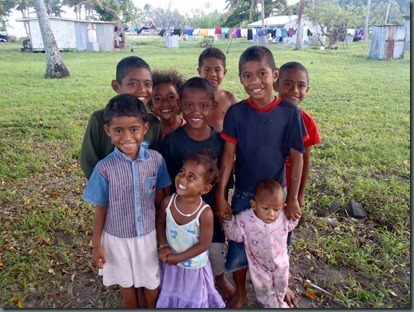
After church we sat down on a grass mat under the shade of swaying palms and enjoyed the fish from our spear fishing expedition the day before. No work on Sunday so all the food had to be gathered on Saturday, then prepared in the morning between services. The rest of the day is reserved for resting, socializing, eating, and of course more church.
The fish was cooked whole in coconut milk and served with shaved green papaya. Even the eyeballs looking up at me from by bowl couldn’t take away from the delicious blend of natural flavors. The cassava from the lovo was awesome and perfectly moist with a slight infused coconut smoky flavor. The moisture from the palm fronds saturates the oven and bakes it perfectly trapping in the flavor. No chance of drying out anything here.
After lunch we took the village children out to Delos for a treat and tour. There were 15 kids in total, ranging from 4 to 13 years old. Only three of them had ever been off the island and to Suva. They were blown away by the boat. Most of them have never seen any electronics, cars, or buildings. Imagine living your entire life in a small village and now suddenly you’re on a modern sailing boat full of exotic devices like computers, microwave, and IPods.

The electronics, gauges, and controls for sailing blew them away. We treated them with orange soda, M & M’s, and some costume jewelry for the girls. When the children got close enough they would grab your hand and slowly rub your arm, all the while staring at your skin. We saw this in the previous village and it took a while to realize they thought we were wearing something on our skin to make us white, and that if they rubbed hard enough it would come off!
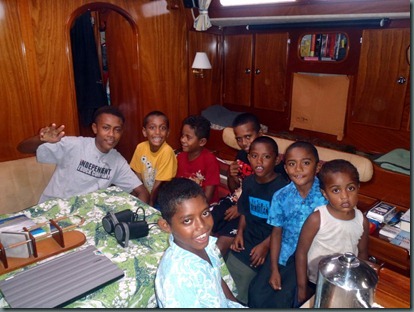
Artifacts found in Fiji suggest the islands were first settled in 1500 B.C. or even earlier, probably by Polynesian people. Some 1000 years later in 500 B.C. the Melanesian people arrived bringing their culture. Fiji was first sighted by Abel Tasman in 1643, and visited by Captain Cook in 1774. The first Missionaries arrived in 1830 and 24 years later in 1854 Chief Cakobau accepted Christianity. The service was a blend of Fijian culture and Christianity in some aspects, but without a doubt predominately Christian. We couldn’t help but wonder how it was before Christianity arrived, before the 3,300 years of native culture was converted by an army of missionaries in 24 years. There hasn’t been a reported act of cannibalism in a while so I suppose that’s a benefit.
